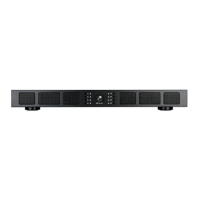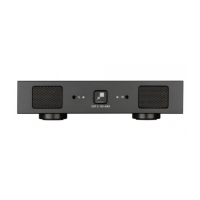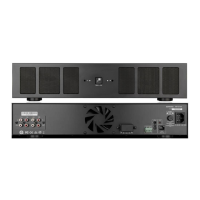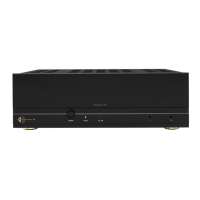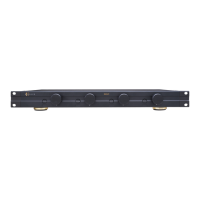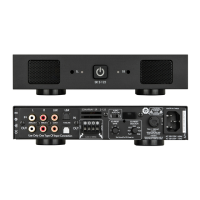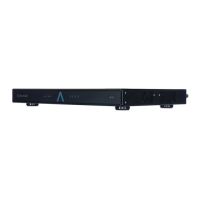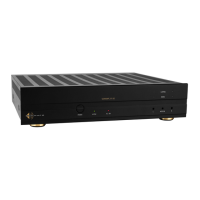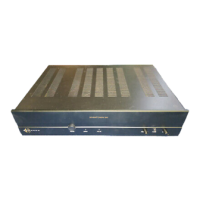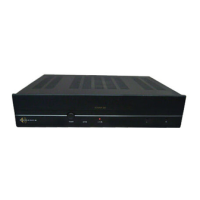Do you have a question about the Sonance DSP 8-130 MKII SONAMP and is the answer not in the manual?
Essential safety guidelines to follow when operating the Sonamp DSP 8-130 MKII amplifier, covering handling, placement, and maintenance.
List of items included in the Sonamp DSP 8-130 MKII amplifier package, such as the amplifier, power cord, and rack ears.
Guidelines for positioning the amplifier to ensure proper ventilation, avoid heat sources, and prevent damage.
Details on the front panel's power button, channel LEDs, and volume controls for operation and status indication.
Information on audio inputs/outputs, trigger, IR, and IP connectivity for system integration.
Guidance on connecting speakers, managing the AC fuse, and proper power cord connection.
Instructions for installing rack ears or attaching feet for shelf mounting the amplifier.
Details on connecting the IEC power cord to the amplifier and the wall outlet.
Table detailing power consumption and breaker requirements for 120V and 220V AC operation.
Instructions for bridging amplifier channels for increased power output, including impedance requirements.
Information on connecting audio sources to the amplifier's inputs and loop outputs.
How to control channel volume via SONARC and front panel controls for desired sound levels.
Details on the amplifier's protection system for channels and indicator LEDs during fault conditions.
Information on the amplifier's power supply protection and related indicator behavior during thermal events.
Guide to connecting the amplifier to the network and accessing its SONARC homepage.
Explanation of SONARC interface elements, legends, and initial setup options.
How to assign pre-configured DSP presets to individual amplifier channels for optimized audio.
Setting input names, selecting sources, and adjusting input trim levels for audio signals.
Defining output names, volumes, and linking turn-on volume to output volume.
Overview of the General Settings tab for network, triggering, and basic amplifier configuration.
Configuring IP settings, DHCP, and using ID Amp Mode for amplifier identification.
Managing IP addresses, subnet masks, and performing DHCP resets.
Functions for backing up, restoring, and printing amplifier settings.
Configuration options for Audio, Audio Green, Voltage, and Voltage Green Auto On modes.
Setting sleep mode to Off, After 15 Minutes, or After 3 Hours for power saving.
Defining output names and setting channels to Stereo or Mono operation.
Assigning DSP presets and grouping channels for simultaneous control.
Configuring input names and adjusting input trim levels for balanced audio sources.
Main volume levels and default turn-on volumes per channel.
Limiting maximum volume and adjusting individual channel gain offsets.
Muting speaker output for channels, with simultaneous changes for grouped channels.
Using the pink noise generator for audio measurement and testing.
Editing existing presets, renaming them, and deleting settings.
Saving and loading all or single presets to manage amplifier configurations.
Steps to import a speaker preset from a computer into the amplifier.
Copying presets between different locations within the amplifier.
Adjusting EQ On/Off, frequency, Q factor, and gain for parametric equalization.
Visual representation of EQ adjustments and their effect on the audio output.
Configuring delay in milliseconds, feet, or meters for speaker synchronization.
Sophisticated bass and treble adjustment using start frequency and gain.
Enabling and setting high-pass/low-pass crossovers with frequency and filter type.
Applying a brick wall limiter to control output power with dB options.
Detailed performance metrics including channel count, output power, frequency response, and SNR.
Information on power requirements, consumption, connectivity protocols, and heat output.
Specifications related to physical size, rack mounting, and shipping weight.
Explanation of the different LED indicators on the amplifier and their meanings.
Step-by-step guides for performing DHCP and factory resets on the amplifier.
Detailed breakdown of Auto On and Sleep Mode settings and their effects on music and Ethernet.
Details of warranty exclusions, limitations of liability, and disclaimers.
Information on warranty period, transferability, coverage limitations, and obtaining authorized service.
| Number of Channels | 8 |
|---|---|
| Signal-to-Noise Ratio | > 100 dB |
| Bridge Mode | Yes |
| DSP | Yes |
| Power Output (8 Ohms) | 130 Watts |
| Power Output (4 Ohms) | 130 Watts |
| Frequency Response | 20 Hz - 20 kHz |
| Total Harmonic Distortion (THD) | 0.05% |
| Input Impedance | 20 kOhms |
| Output Impedance | 4 Ohms |
| Input Sensitivity | 1.0V |

